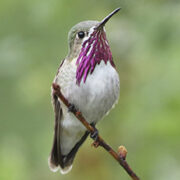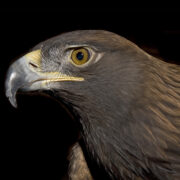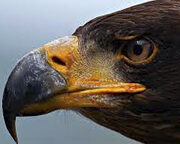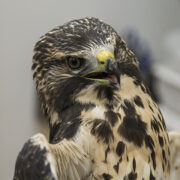Nature News – January 2019
/0 Comments/in Nature News/by Terry StevensOf a Feather
Greg Martin
Liberty Wildlife Contributing Author
A feather is not an external tool. But nor is it a traditional appendage. Feathers define almost every aspect of a bird’s 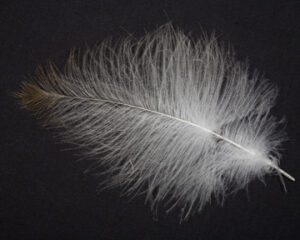 existence: downy feathers protect from the elements, while primary, secondary, and tail feathers provide the miracle of flight that gives them their incomparable edge. Plumage variations can: attract mates, as in the case of the peacock; help birds ward off predators or hide from prey through skillful camouflage, as seen in species big and small; even provide stabilization to younger birds that need the help. Immature Red-tailed Hawks, for instance, possess longer tail feathers than their adult counterparts, giving them added forgiveness while learning to fly, in the same way that training wheels help a human child’s first tentative moments on a bicycle. Feathers come in specialized forms in different species for different circumstances. Waterproofing is far more important to a duck than an owl; indeed, the Great Horned Owl actually sacrifices the ability to waterproof its coat in exchange for special feather characteristics that enable it to glide silently through the air.
existence: downy feathers protect from the elements, while primary, secondary, and tail feathers provide the miracle of flight that gives them their incomparable edge. Plumage variations can: attract mates, as in the case of the peacock; help birds ward off predators or hide from prey through skillful camouflage, as seen in species big and small; even provide stabilization to younger birds that need the help. Immature Red-tailed Hawks, for instance, possess longer tail feathers than their adult counterparts, giving them added forgiveness while learning to fly, in the same way that training wheels help a human child’s first tentative moments on a bicycle. Feathers come in specialized forms in different species for different circumstances. Waterproofing is far more important to a duck than an owl; indeed, the Great Horned Owl actually sacrifices the ability to waterproof its coat in exchange for special feather characteristics that enable it to glide silently through the air.
Yet for all that, feathers are categorically different from, say, the thin, membrane-like skin of a bat’s wings. They are not a permanent part of avian anatomy. As they age, birds gain and lose countless feathers in a predictable annual cycle called the “molt.” Just as a shark continually replaces its teeth throughout its lifetime, birds  habitually discard old, worn out feathers with new ones that grow in their wake. The molt is incredibly well orchestrated from a biological perspective: since the overwhelming number of avian species rely upon their feathers for flight, losing them all at once would be a death sentence. Instead, feathers shed sequentially and symmetrically, a few at a time, ensuring that their temporary loss is more than compensated for by those that remain. This staggered shedding process also ensures that new growth remains safely buffered by older feathers capable of absorbing the brunt of any unforeseen impacts. Remember that birds of prey routinely collide with their food (and the ground). The better the hunter, the more likely that their plumage takes a thorough beating. The molt is necessary maintenance that allows them to keep going, sometimes for decades on end.
habitually discard old, worn out feathers with new ones that grow in their wake. The molt is incredibly well orchestrated from a biological perspective: since the overwhelming number of avian species rely upon their feathers for flight, losing them all at once would be a death sentence. Instead, feathers shed sequentially and symmetrically, a few at a time, ensuring that their temporary loss is more than compensated for by those that remain. This staggered shedding process also ensures that new growth remains safely buffered by older feathers capable of absorbing the brunt of any unforeseen impacts. Remember that birds of prey routinely collide with their food (and the ground). The better the hunter, the more likely that their plumage takes a thorough beating. The molt is necessary maintenance that allows them to keep going, sometimes for decades on end.
When we think of feathers, we imagine them impossibly light, bound to a firm hollow shaft, that is remarkably strong, given its makeup. During initial growth, that shaft acts as a conduit, carrying blood from the bird’s body to facilitate feather growth. 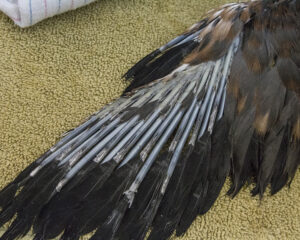 Anyone who has ever worked with birds in any context, or owned them as pets, is familiar with the fragile nature of “blood feathers.” The hardening of the shaft only takes place at the end; until that occurs, growing feathers are delicate things, prone to breaking. Such damage can be potentially hazardous, as ruptured shafts continue to drain blood unless plucked. Once a feather completes its growth, the shaft hardens and the flow of blood ceases. Damage after that point has no directly ill effect upon the owner, beyond the limitations that too many broken feathers might impose on swift flight.
Anyone who has ever worked with birds in any context, or owned them as pets, is familiar with the fragile nature of “blood feathers.” The hardening of the shaft only takes place at the end; until that occurs, growing feathers are delicate things, prone to breaking. Such damage can be potentially hazardous, as ruptured shafts continue to drain blood unless plucked. Once a feather completes its growth, the shaft hardens and the flow of blood ceases. Damage after that point has no directly ill effect upon the owner, beyond the limitations that too many broken feathers might impose on swift flight.
Many birds seem fascinated with their old feathers after the fact. Nest linings often include molted feathers, and raptors have been known to pick up and drop, then pick up again, their discarded feathers, as if delighted by their gentle, spiraling descent to the ground. More than a tool, yet less of a permanent fixture than one might think, feathers are to them what all the accoutrements of human society are to us. For shelter, for food, for transport, for beauty … for life itself, no matter the species, feathers make them what they are.
Plants as Nectar Factories
Gail Cochrane
Liberty Wildlife Volunteer
Learning about the birds and the bees is often a euphemism for the “sex talk”. Well, let’s set aside the bees for now, and talk about the birds and the blossoms. Plants that accomplish the sex act, or pollination, with the help of birds, are known as ornithophilous.
Birds of the Sonoran Desert commonly known to involve themselves in the sexual lives of plants include hummingbirds and white-winged doves. Bats are pollinators of the night bloomers. All of these critters rely to some lesser or greater degree on plant nectar while nectar-producing plants must have help with pollination in order to reproduce.
Nectar comes from Greek roots that mean overcoming death. Without the flowers to provide them with sugars, carbohydrates, amino acids, water, ions and other compounds, pollinating birds such as hummingbirds would not survive. I was watching a hummingbird feed at chuparosa blossoms and got to wondering about nectar production. How much nectar is in those flowers and how does it get there? Does it ever run out?
Plants produce nectar in glands called nectaries. Moisture is pulled from the plant phloem and sugar and other compounds are  added. The nectar is secreted from epidural cells through pores such as trichomes or stomata. Floral nectaries may be on any part of a plant’s budding flower including the petal, stamen, sepal or ovary. The placement of the nectary as well as the shape of the flower directs the pollinator where it is most likely to brush against reproductive organs of the plant, thus picking up pollen. The distribution of pollen is the pay-off for the plant. Over time, the various types of nectaries have evolved to suit the pollinators that best serve the plant’s needs.
added. The nectar is secreted from epidural cells through pores such as trichomes or stomata. Floral nectaries may be on any part of a plant’s budding flower including the petal, stamen, sepal or ovary. The placement of the nectary as well as the shape of the flower directs the pollinator where it is most likely to brush against reproductive organs of the plant, thus picking up pollen. The distribution of pollen is the pay-off for the plant. Over time, the various types of nectaries have evolved to suit the pollinators that best serve the plant’s needs.
Extrafloral nectaries may be located on leaves, stems, or petioles. This nectar is used to attract plant defenders, such as ants or wasps. Extrafloral nectar is only produced when the plant is being threatened by predators such as aphids, or caterpillars. The defenders come to feed on the nectar and while they are there, feed as well on the plant’s attackers.
The chuparosa shrub I was watching is an important food source for desert hummingbirds in the winter. The red tubular flowers hold their nectar in the base of the bloom, accessible to the hummingbird with its long bill and tongue. Typically, hummingbirds search visually for tubular red or orange flowers. They need a high volume of flowers as each bloom holds only a tiny drop of nectar.
Migratory species of hummingbirds such as the Rufous and Broad-Billed are especially dependent on flowering sources of nectar along their migratory route. The high metabolism that allows them to fly long distances in chilly or wet weather also requires regular infusions of nectar sugar. The timing of flower to migration is critical to prevent the birds from having to spend too much time foraging.
 The Sonoran Desert’s iconic saguaro cacti bloom primarily at night, so they are often pollinated by nectar-feeding bats. Saguaro flowers open between 10 pm and midnight and close around noon the following day. Nectar production begins after the flower opens and continues for several hours after sunrise. Each flower produces 2 ml of nectar and .5 grams of sugar. The flower also produces large amounts of pollen. In addition to the bats, these flowers are pollinated in the mornings by white-winged doves, Gila woodpeckers and curved-billed thrashers. There is a synchronicity between migration of bats and white-winged doves and the flowering of saguaros.
The Sonoran Desert’s iconic saguaro cacti bloom primarily at night, so they are often pollinated by nectar-feeding bats. Saguaro flowers open between 10 pm and midnight and close around noon the following day. Nectar production begins after the flower opens and continues for several hours after sunrise. Each flower produces 2 ml of nectar and .5 grams of sugar. The flower also produces large amounts of pollen. In addition to the bats, these flowers are pollinated in the mornings by white-winged doves, Gila woodpeckers and curved-billed thrashers. There is a synchronicity between migration of bats and white-winged doves and the flowering of saguaros.
Next time you see a hummingbird feeding at a blooming plant, or see a white-winged dove perched at a saguaro flower you can be sure that the plant’s nectar factory is in full swing.
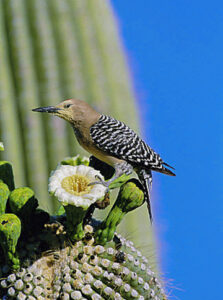
Source: Conserving Migratory Pollinators and Nectar Corridors in Western North America edited by Gary Paul Nabhan
IS IT A BEAK OR A BILL?
Claudia Kirscher
Liberty Wildlife Volunteer
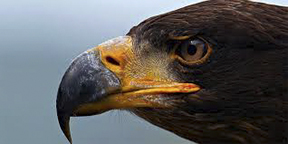
There is no difference between the two terms. Beak is more commonly used for birds of prey and for striking or pecking; bill for hummingbird, pigeons, waders, and web-footed birds; either for crows, finches, sparrows, perching birds, and songbirds.
Birds have evolved their bills to a wide variety of shapes and sizes to help them survive by adapting to their food sources. It is used in finding, capturing, and manipulating animal prey or plant food, preening, courtship, defense, building nests, communicating, and feeding young. One can usually identify a bird’s food preference by the shape of the bill.
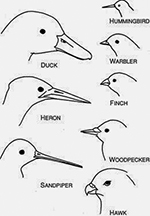
Bills are a compact layer of epidermal cells (keratin) molded around the bony core of the upper and lower mandibles (jaws). Two holes (nares) lead to the respiratory system in most species. The bill grows and birds have to constantly wear it down by rubbing on branches and rocks. Sometimes captive birds have to have their bills trimmed as they do not wear them down as they would in the wild.
In nearly all birds, unlike mammals, both upper and lower jaws can move, the top mandible has limited motion upwards. The mandibles are attached by bones, muscles, and tendons to the skull. With this ability of movement, some birds, especially shorebirds, can probe into sand or soil and just open the tips of their bills to feel for prey.
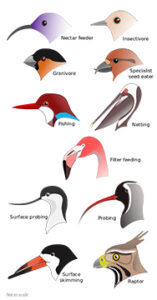
Finches: Conical bills for cracking seeds, bill size correlates with preferred seed size.
Crossbills: Feed almost exclusively on conifer cones by twisting out seeds with crossed beak.
Flycatchers: Tweezer-like beaks to grab insects in midair.

Warblers: Thin, slender, pointed beaks to pick insects off leaves, twigs, and bark.
Nighthawks: Open mouth, gaping, for chasing and scooping insects in flight.
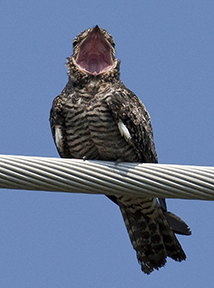
Woodpeckers: Chisel-like bills to dig and burrow into tree bark for insects which they pull out with an elongated tongue.
Stilts, avocets and shorebirds: Long bill used like forceps into the sand, but also have sensitive nerve endings on edge of bill to detect prey.
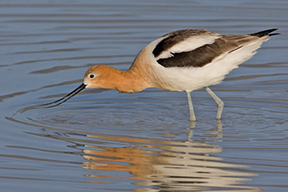
Snail kite: sharply hooked beak to reach into the snail shell.
Hawks, eagles, owls and falcons: Strong bill, hooked for tearing flesh into small enough pieces to swallow.
Brown pelican: Very long bill with large throat pouch used to scoop up fish.
Great blue heron: Spear-like bill for jabbing fish, frogs and shellfish.
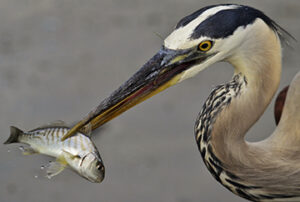
Northern cardinal: Heavy cone-shaped bill for cracking seeds.
Ducks: Strainer/filter beaks: Long flat bill that strains animals or plants from the water.
Hummingbird: Slender and long to probe nectar from flowers.
Is it a beak or a bill? Your choice!
References: allaboutbirds.org; ornithology.com; Wikipedia.org; BirdWatching magazine
Kid Stuff

Carol Suits
Nurturing Nature
Did You Know?
IF IT HAS FEATHERS, IT’S A BIRD! Birds are the only living creatures with feathers. Feathers are made of keratin, the same protein that makes up a bird’s beak, lizard scales, mammal hair, human fingernails, animal hooves, and horns! Feathers help birds fly and keep them warm and dry. The color pattern of feathers, called “plumage,” can help birds stay camouflaged or find mates.
What happens when a bird gets wet? Do feathers help keep it dry and warm? https://www.birdnote.org/show/what-happens-when-birds-get-wet
How do feathers help a bird stay warm on a cold night? https://www.birdnote.org/show/birds-cold-night
Find out about bird beaks and how birds use them. https://www.youtube.com/watch?v=G_SWxGP-1jE
Here are two books for you to read.
Feathers are not Just for Flying
Read about how feathers of all shapes and sizes help birds with warming or cooling, protect them from the sun, help them swim, glide or even dig. Feathers are not Just for Flying by Melissa Stewart and Sarah Brannon is part science journal, part read-along nonfiction. https://www.goodreads.com/book/show/17870871-feathers Gr 1 – 4
Beaks!
In this book, you will learn about several different birds, their habitats, and how their beaks are styled to help them survive. You will see 3-D cut pictures by Robin Brickman of birds in their natural environments with their beaks in action. There is also a quiz, a bibliography, and a list of web sites to learn more. https://www.goodreads.com/book/show/1621377.Beaks_?from_search=true Gr. K – 4
Thank you for supporting Liberty Wildlife!
/4 Comments/in Uncategorized/by Terry StevensYour gift to support the orphaned animals in our care at Liberty Wildlife has led to many success stories. We want to share just a few of the recent releases from this spring’s “graduates.”
Donate
Help us reach our financial goals in treating 12,000+ animals per year.
Donate Now!Donations are tax deductible.
Emergencies
If you have a wildlife emergency and are in need of assistance, contact us immediately.
If you do not reach someone right away, please leave a message and we will return your call as soon as possible.Drop Off
Have you found an injured animal in need of help? Bring them by our new facility.
2600 E. Elwood St.
Phoenix, AZ 85040

